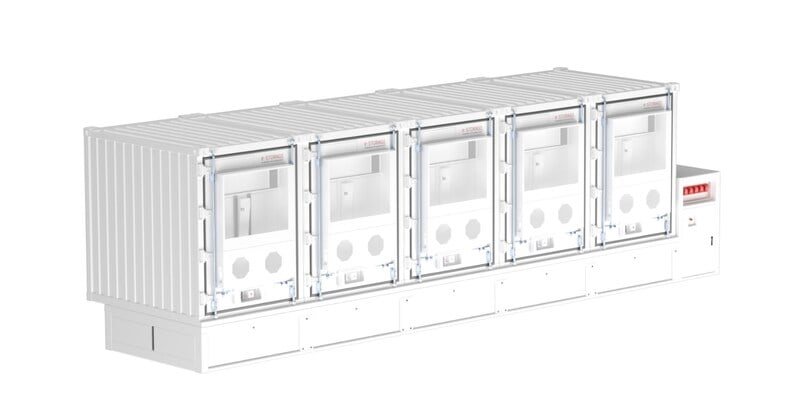RE+ 2025: Product launches, showcases and news ahead of the biggest clean energy trade show in the US

At the same time, US-China tariffs have fed into uncertainty in procurement decisions. However, Fluence pointed out that it had already been moving to onshore its supply chain since 2022.
Fluence sources cells in the US from AESC’s factory in Tennessee, while at its own factories it builds enclosures in Arizona, makes modules in Utah and thermal management and HVAC equipment at a newly opened facility in Texas.
In August, the company guided investors to the lower range of previously offered revenue guidance for its 2025 financial year, due to delays in ramping up its production sites, particularly the one in Arizona.
CEO Julian Nebreda said in an earnings call to explain quarterly results that the Arizona plant had experienced “some typical ramp-up issues” but justified the supply chain investments in asserting his and his company’s view that the US will in future be “a domestic content market.”
By Andy Colthorpe.
Canadian Solar’s energy storage arm, e-Storage, will debut its FlexBank 1.0 BESS solution at RE+. The solution offers up to 8.36MWh of capacity by stacking modular cabinets and the company claimed it is suited for a range of utility-scale applications.
E-Storage, a subsidiary of vertically integrated solar PV manufacturer Canadian Solar’s manufacturing subsidiary CSI Solar, announced the launch yesterday. The scalable platform is expected to be available for deliveries next year.
FlexBank 1.0 features 314Ah lithium iron phosphate (LFP) cells from e-Storage, while the solution’s modular open-frame architecture means that each cabinet functions as an independent building block of the system, which according to Canadian Solar simplifies site logistics and installation.

Other features include a multi-level safety protection system including heat barriers to protect cells within each cabinet, three-level electricity protection and cell-level precision management. Meanwhile the modular design is intended to prevent propagation of fire from one cabinet to another.
Cabinets come in either 800kW/1600kWh or 400kW/1600kWh rated DC power and capacity, and when combining up to five cabinets offer 4,000kW/8000kWh or 2,000kW/8,000kWh power and capacity depending on make and model.
Canadian Solar is another BESS provider looking to onshore as much of its US supply chain as it can. The company is building a battery cell manufacturing plant in Kentucky with 6GWh annual production capacity, expected to open in the first quarter of 2026. It is one of just four companies with publicly announced LFP battery cell manufacturing capacity for stationary BESS applications in the US.
By Andy Colthorpe.
Software-focused energy storage system integrator FlexGen has announced a new Solar Power Plant Controller (PPC) integrated with the company’s energy management system (EMS) HybridOS.
With PPC capabilities in HybridOS, users can manage solar assets and components such as solar arrays, trackers, MET stations, and capacitor banks.
FlexGen emphasises that this new addition allows operators to manage solar and storage through a single platform, claiming it will cut out the cost and delays of juggling multiple control systems.
Meanwhile, for operators focusing solely on solar, the company states that HybrisOS optimises energy production and helps them capture and shift curtailed solar power into the evening hours.
Hugh Scott, Chief Technology Officer at FlexGen, said of HybridOS’s new functions, “Bringing grid-scale solar controls into HybridOS is a natural progression.”
Scott continued, “This reflects how many of our customers already pair solar plants with energy storage systems.”
It also took over Powin’s spare parts inventory. Powin’s field projects will now be linked to FlexGen’s Remote Operations Centre (ROC), and Powin customers will have access to HybridOS.
By April Bonner.
Trina Storage will showcase its Elementa 2 Pro Platform utility-scale storage solution at RE+. The platform will be available in two turnkey configurations: a 10 MWh (2-hour) system and a 20 MWh (4-hour) system.
Trina Storage is the energy storage arm of the Chinese vertically integrated solar PV company Trinasolar.
The Elementa 2 Pro Platform was launched in North America on 26 August. This will be Trina Storage’s first major exhibition of the solution.
Trina Storage describes the platform as a “fully wrapped, cell-to-AC solution designed for the specific demands of the grid-scale energy storage market.”
The company states that the storage solution can be utilised for grid balancing, renewable energy integration, and capacity services. Its streamlined architecture combines battery cells, power conversion, and control systems, making it easier for developers and EPCs to reduce integration complexity and speed up deployment.
Trina Storage recently partnered with FlexGen on a 371MWh BESS project for SMT Energy in Houston, Texas. Trina noted that it was the largest grid-scale BESS project in North America that the company had worked on.
Terry Chen, Vice President of Trinasolar North America, said of showcasing the Elementa 2 Pro Platform at RE+, “With North America leading large-scale energy storage deployment, RE+ 2025 is the perfect stage to share our latest solutions and insights.”
By April Bonner.
energy-storage





